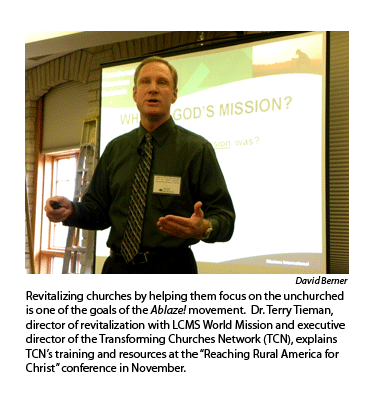By Roland Lovstad
There is an unknown constituency in the midst of the Ablaze! goal to revitalize 2,000 congregations by 2017: they are the ones with no church home or those who don’t yet know Jesus as their Savior.
“Even though we don’t have direct contact, we’re always thinking about the lost and unchurched as we develop resources and training,” emphasizes Dr. Terry Tieman, director of mission revitalization with LCMS World Mission. “They are the people this is designed for because we want more of those folks to spend eternity with Jesus.”
Reflecting a unique partnership, Tieman also is executive director of the Transforming Churches Network (TCN), which has developed training and resources for congregational revitalization. TCN is currently working with 30 LCMS districts to train consultants and coaches for congregations. About 320 congregations are now involved in the revitalization process.
“Our purpose is to turn inwardly focused congregations to look outward,” Tieman explains. “We talk a lot about mission and, of course, our mission is God’s mission in that He wants to reconcile mankind through His Son, Jesus, and bring us all into a relationship with Him.”
TCN had its start in the Mid-South District, where Tieman, as a mission executive, saw mission congregations start with enthusiasm and rapid growth, then plateau in membership and worship attendance. He developed a one-to-two-year process that includes “learning communities” for pastors and lay leaders, a visit by a consulting team, and ongoing coaching for pastors and leaders. TCN also prepares study materials for pastors and leaders who are involved in learning communities.
“We’ve seen some remarkable things,” says Tieman. He cites increases in worship attendance, offerings, baptisms, confirmations, lay leadership, and community involvement.
“But probably the biggest thing I hear from congregations and pastors is that this has given them hope for the future and joy in ministry,” he said. “They have hope that they will not only continue to function, but impact their community with the Gospel — and joy that they are carrying out the mission of God and the ministry that Jesus gave them.”
While he believes congregations intuitively understand that their mission is to reach people with the Gospel, Tieman observes a tendency for them to tend to the needs of current members. TCN helps congregations focus on the community and the mission to share salvation in Christ, he says. TCN does not pit nurture and care of current members against reaching the lost, but brings a “both/and” focus to swing the pendulum more to reaching their communities.
TCN and the revitalization process primarily target congregations in which worship attendance has reached a plateau or is in decline.
The ideal time is when a congregation may seem to have peaked in its life cycle and is experiencing a small decline. “The perception may be, ‘We’re doing great, the bills are paid, the pews are relatively full, everybody’s happy,’ ” Tieman comments. “But that’s the best time to start, because that type of congregation still has resources that can be focused outward.”
It’s not true that TCN works only with desperate churches, he adds. “We will work with all congregations. However, desperation indicates a willingness to look at deep changes to become focused on God’s mission.”
The TCN process really works best with growing churches, according to the director. “The healthier the church, the easier for them to regain their mission focus or to build momentum in reaching those who need to know Christ.”
The TCN process begins with a district staff meeting with a congregation to explain the process. The pastor may be connected to a learning community with other area pastors and, after a couple of months, may begin a learning community for leaders in his congregation. Then, after prayer and discussion, the congregation determines whether to continue with a consultation.
Consultations begin with the congregation conducting a self-study over two to three months. That is followed by a weekend visit by a two- or three-person team trained in leading a change process. During the consultation weekend, the team writes a report citing five strengths, five concerns, and five “prescriptions” with deadlines. Then, the congregation decides if it wishes to continue in the process and accept the report.
If congregations elect to continue the process, the district assigns “coaches.” One coach meets monthly with the pastor, in person or electronically. Another coach meets at least quarterly with the congregation.
Through October, TCN had trained 221 consultants, including 30 who are certified to lead consultations. It also has trained 88 coaches, who may be full-time parish pastors, retired pastors, or district staff.
“Districts realize they need more coaches. This is a key to the success of the process,” Tieman comments. He compares coaching to dieting or trying to quit smoking: the process is more successful with someone to encourage and hold a person accountable.
Pastors appreciate the learning communities, according to Tieman. “Many have said the communities are the best thing they do every month, because they are with their peers, they are being prayed for, and they’re working with other men who have the same interests and values,” he says.
Every district has its own plan for recruiting congregations into the revitalization process, so Tieman advises congregations to contact their district office for more information.
TCN receives about half of its funding from LCMS World Mission. The balance of its operation is supported by a grant from Thrivent Financial for Lutherans, TCN’s own fundraising, and below-cost fees for training and resources.
For more information, visit the TCN Web site at www.transformingchurchesnetwork.org.
Roland Lovstad is a freelance writer and a member of Immanuel Lutheran Church, Perryville, Mo.
Posted Dec. 30, 2009




